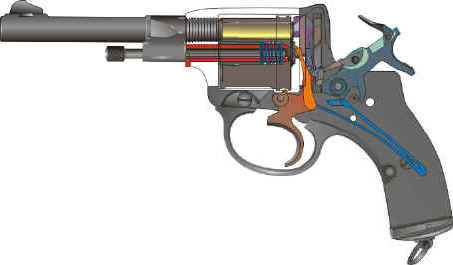Hi there, I've been searching my physics fueled thoughts for a way to eliminate the pressure escaping from the revolvers' cylinder gap for obvious reasons. Cutting into the top strap of the frame is only one small part of my motivation. Other valid reasons include improved velocity, preventing pressures from blowing back into other rounds, deadly knife cutting pressures that limit how one handles the revolver when firing covers several reasons why this needs addressing as a primary issue. When referring to a high pressure cartridge, it becomes monumental from a safety stand point. I can't understand why this hasen't, at least to my knowledge, been addressed and solved, especially since the revolver and its variations have been around for so long. After nearly 30 years of serious thought and evolving diagrams, I have found a practical solution. Using high tech metal, such as titanium, a quite simple shroud can be easily machined to work on any revolver. To most this wouldn't seem a practical or even necessary modification. But to an individual who has closely observed the effects of escaping pressures, I've realized the magnitude of the design flaw when this type of weapon was created. Although I have found the after market solution to be rather simplistic, a design that includes such a solution during manufacturing is a far more simple process and based on the concept, shouldn't have a major impact on the price.
Thanks for your time to review this thought and I hope to hear some of you to see if I am on to something new and worthy of addressing even. As I stated, a reliable and simple yet precision design will completely eliminate escaping pressures that can actually be applied to the performance of the weapon, eliminate safety issues, and extend the life of parts and main frame integrity.
"When seconds count, the police are only a few minutes away"
Thanks for your time to review this thought and I hope to hear some of you to see if I am on to something new and worthy of addressing even. As I stated, a reliable and simple yet precision design will completely eliminate escaping pressures that can actually be applied to the performance of the weapon, eliminate safety issues, and extend the life of parts and main frame integrity.
"When seconds count, the police are only a few minutes away"
Last edited:

